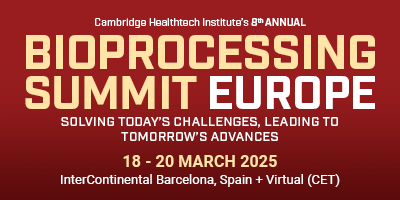인터랙티브 브레이크아웃 디스커션
인터랙티브 브레이크아웃 디스커션은 비공식 및 모더레이트 유형의 디스커션입니다. 참가자는 아이디어 및 경험을 교환하고, 특정 토픽에 대해 향후 협업을 발전시킬 수 있습니다. 각 디스커션은 진행자가 주도하며, 진행자는 토론의 진행과 그룹 참여도를 유지합니다. 이 기회를 최대한 활용하려면 자신의 연구 사례를 공유하고, 집단적인 문제 해결 세션에 참가하며 활발한 아이디어를 공유할 준비를 해주시기 바랍니다.
인터랙티브 브레이크아웃 디스커션은 대면 형식으로만 진행됩니다.
3월 19일(수) 18:00 - 18:30
Cell Culture and Cell Line Engineering - Part 2
TABLE 1: Digital Bioprocessing and Industry 4.0: How Far Along Are We?
Mark Duerkop, CEO, Novasign GmbH
- Critical evaluation of the current industrial evolution
- AI vs mechanistic modelling: what to choose?
- Workflow vs data: where to invest?
- Outlook on how AI will change the way of bioprocessing in the future
TABLE 2: Economic and Sustainability Considerations for Hybrid Processes (Single Use/Stainless)
Stefan Junne, PhD, Associate Professor, Bioscience and Engineering, Aalborg University
- Definition and examples of hybrid processing
- Benefits for process flexibility and continuous operation
- Technical, logistical and regulatory burdens
- Sustainability considerations
- Will hybrid processing give a boost for single-use equipment beyond biopharma?
Advances in Recovery and Purification - Part 2
TABLE 3: Virus Clearance Strategies in Bioprocessing
Alois Jungbauer, PhD, Professor & Head, Biotechnology, Institute of Bioprocess Science and Engineering, BOKU University
- ICH Q5 A (R1) Revision: Viral safety Evaluation of Biotechnology
- Products Derived from Cell Lines of Human or Animal Origin Expectations
- What has changed and the Impact on bioprocessing
- Viral clearance strategies in continuous processing
- Virus removal
TABLE 4: Optimizing Partnerships: Strategies for Effective CMO/CDMO Management in Bioprocessing
Tarik Senussi, PhD, Head of Technology Transfer, New Technologies, Recordati
- Defining Success Metrics: Key performance indicators for evaluating CMO/CDMO partnerships in bioprocessing projects
- Communication Strategies: Ensuring alignment through clear communication, project updates, and expectations management
- Risk Mitigation: Identifying and addressing common challenges such as quality assurance, timelines, and regulatory compliance
- Scaling and Innovation: Leveraging CMO/CDMO expertise to navigate scale-up/down challenges and integrate emerging technologies
Gene Therapy Manufacturing
TABLE 5: Viral Vector Manufacturing-From Niche Science to an Industry, Now with Those Growing Pains
Jack Cordrey, PhD, EMEA Senior Bioprocessing Applications Specialist, Purification & Filtration, Solventum
- Regulatory environment-today and future concerns.
- Cell line and productivity-triple transfection or stable cell line?
- Early impurity removal-its impact downstream
- Encapsulation-how do we tackle empty, partial, full, and genomic DNA?
- DNA Endonuclease addition-how confident are we that we can remove this CMC concern??
Intensified and Continuous Processing
TABLE 6: Integrated and Continuous Processing
Lara Fernandez-Cerezo, PhD, Associate Principal Scientist, Merck Sharp Dohme (MSD)
- Implementing advanced control process technologies to continuous processes
- Beyond monoclonal antibodies (mAb): applying continuous manufacturing to a diversified pipeline
- Breaking barriers to enhance adoption of continuous manufacturing: how?
TABLE 7: Sustainability in Biomanufacturing
Clare Thompson, Global Change Facilitator, BioPhophorum
Darryl Ratty, Executive Director, Global ESG, SK Pharmteco
- Explore the main environmental concerns in biomanufacturing such as water use, plastics, and energy consumption
- Examine a structured framework that guides organizations in enhancing their sustainability practices
- Discuss specific measures that can be implemented by manufacturing facilities to minimize their environmental impact
- Critical environmental challenges in biomanufacturing and innovative solutions to address them
Next-Generation Analytical Methods
TABLE 8: Developability Assessment of Biotherapeutics - A Solved Problem or an Outstanding Challenge?
Hristo Svilenov, PhD, Associate Professor, TUM
- Common developability pitfalls for novel modalities (e.g., bispecifics, ADCs)
- Strategies for mitigating aggregation, instability, and immunogenicity
- Real-world constraints in applying developability frameworks
- Evolving regulatory expectations for developability data
* 주최측 사정에 따라 사전 예고없이 프로그램이 변경될 수 있습니다.















